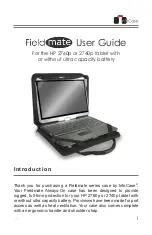
93
APPENDIX
IDE (Integrated Drive Electronics)
IDE devices integrate the drive control circuitry directly on the drive itself, eliminating the need for a
separate adapter card (in the case for SCSI devices). UltraDMA/33 IDE devices can achieve up to
33MB/Sec transfer.
IEEE1394
Also known as iLINK (Sony) or FireWire (Apple). IEEE1394 is a high speed serial bus like SCSI but
has simple connections and hot-plugging capabilities like USB. The interface IEEE1394 has a band-
width of 400-1000 Mbits/sec and can handle up to 63 units on the same bus. It is very likely that
IEEE1394, together with USB, will replace Parallel, IDE, SCSI, and EIDE ports. IEEE1394 is also
used in high-end
digital equipment and should be marked “DV” for Digital Video port.
Infrared Port (IrDA)
The infrared (IrDA) communication port allows convenient wireless data communication with infra-
red-equipped devices or computers up to 4 Mbits/sec. This allows easy wireless synchronization with
PDAs or mobile phones and even wireless printing to printers. If your office supports IrDA networking,
you can have wireless connection to a network anywhere provided there is a direct line of sight to an
IrDA node. Small offices can use IrDA technology to share a printer between several closely placed
Notebook PCs and even send files to each other without a network.
Kensington
®
Locks
Kensington
®
locks (or compatible) allow the Notebook PC to be secured usually using a metal cable
and lock that prevent the Notebook PC to be removed from a fixed object. Some security products may
also include a motion detector to sound an alarm when moved.
LPT Port (Line Printer Port)
Logical device name reserved by DOS for the computer parallel ports. Each LPT port is configured to
use a different IRQ and address assignment.
PCI Bus (Peripheral Component Interconnect Local Bus)
PCI bus is a specification that defines a 32-bit data bus interface. PCI is a standard widely used by
expansion card manufacturers.
PC Cards (PCMCIA)
PC cards are about the size of a few stacked credit cards and have a 68-pin connector at one end. The PC
Card standard accommodates a number of function, communication, and data storage expansion options.
PC cards come in memory/flash cards, fax/modems, networking adapters, SCSI adapters, MPEG I/II
decoder cards, and even wireless modem or LAN cards. The Notebook PC supports PCMCIA 2.1, and
32bit CardBus standards. The three different PC Card standards actually have different thicknesses.
Type I cards are 3.3mm, Type II cards are 5mm, and Type III cards are 10.5mm thick. Type I and Type
II cards can be used in a single socket. Type III cards take up two sockets and must be used on Notebook
PCs with two sockets.
Содержание M1A
Страница 1: ...NOTEBOOK PC USER S MANUAL Product Name Notebook PC Manual Revision 1 01 E671 Release Date March 2001 ...
Страница 10: ...10 ...
Страница 11: ...11 About This User s Manual Caring Information Transportation Precautions 1 INTRODUCING THE NOTEBOOK PC ...
Страница 15: ...15 Top Side Bottom Side Left Side Right Side Rear Side Front Side 2 KNOWING THE PARTS ...
Страница 60: ...60 ...
Страница 80: ...80 ...
Страница 81: ...81 Appendix PortDock Accessory PortBar Accessory Internal Modem Compliancy Glossary Owner Information ...
Страница 90: ...90 APPENDIX ...
Страница 97: ...97 APPENDIX ...






































